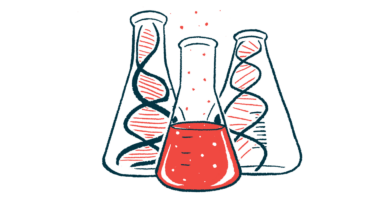In China, pain, nervous system symptoms are most common in AIP
Abdominal pain affects 95% of patients, but treatments are limited: Study

Acute intermittent porphyria (AIP) manifests in a variety of ways, but in China, the most common symptoms are abdominal pain and problems resulting from damage to the brain and spinal cord, a review study has found.
Nearly all Chinese patients with AIP — about 95% — experienced abdominal pain, often along with other gastrointestinal or related symptoms.
Depending on a patient’s genotype, or genetic makeup, the disease’s clinical presentation or phenotype may be more or less severe, which may have implications for diagnosis and treatment, according to the researchers.
“The genotype-phenotype association helps guide clinical diagnosis and treatment. However, the treatment for AIP in China is limited and monolithic,” the team wrote. “More attention needs to be paid to the treatment.”
The study, “Clinical feature and genetic analysis of HMBS gene in Chinese patients with acute intermittent porphyria: a systematic review,” was published in the journal Frontiers in Genetics by a team of researchers in China.
Patients found to have 97 different AIP-causing gene mutations
AIP is caused by mutations in the HMBS gene, which codes for an enzyme of the same name. This enzyme is responsible for the third step in the process cells use to make heme — a component of many proteins, such as hemoglobin, which carries oxygen in red blood cells.
Mutations in HMBS reduce the enzyme’s activity and limit the amount of heme that can be made. As a result, porphyrins formed in the first two steps in the process of making heme build up to toxic levels in body tissues, causing a range of disease symptoms.
At present, however, “there is insufficient knowledge and research on AIP in China, which can easily lead to misdiagnosis and mistaken treatment in clinical practice,” the team wrote.
“How to provide timely and accurate diagnosis and treatment is a major challenge,” the researchers added.
To know more, the scientists reviewed data from 41 studies — 21 in English and 20 in Chinese — involving a total of 160 patients from across China. Most of the studies were case reports.
Altogether, 97 different mutations in the HMBS gene were identified.
“Since the symptoms of AIP are not specific, diagnosis is usually delayed, and molecular analysis of the HMBS gene has become the most useful diagnostic test,” the researchers noted.
A little more than one-third of the mutations (36.1%) were missense, according to the team, causing one amino acid — a protein building block — from being replaced with a different one at a specific position of the enzyme sequence.
A total of 29 (29.9%) were frameshift mutations, which disrupt the reading frame of a gene’s DNA sequence by inserting or removing nucleotides, which are the basic building blocks of DNA.
A further 24 mutations (24.7%) affected splicing, the process by which certain parts of a gene are cut and joined together in different combinations. There also were nine nonsense mutations (9.3%), which result in the production of a shorter-than-usual enzyme.
While most mutations were unique to a family, more than one-fifth — 21 in total, or 21.6% — were found across unrelated families. The most common mutation was c.517C>T, which was found in 16 unrelated families. More than half of the mutations (60.8%) were either known or considered likely to cause disease.
Over half of patient symptoms tied to brain and spinal cord damage
Clinical data were available for 77 patients, most of whom were women (84.4%) and in the age range of 18 to 39 (83.1%). The urine of 38 patients was checked for the presence of porphobilinogen, a heme precursor, and all the tests came back positive.
Among the patients, the most common symptom was abdominal pain, affecting 94.8%. This often was accompanied by nausea and vomiting, or constipation, and in some cases with the eating disorder anorexia.
Some acute AIP attacks experienced by patients in this study were found to be related to menstruation and depression, according to the researchers. These attacks were reduced with hormone therapy and antidepressants.
However, the team noted, in general, that “women aged 18-40 years with recurrent abdominal pain and/or neuropsychiatric symptoms associated with menstruation or dietary factors should be alerted to the possibility of AIP.”
More than half of the patients (54.8%) had symptoms related to the brain and spinal cord, such as headache, dizziness, fainting, and seizures.
Symptoms of the autonomic nervous system, which controls involuntary processes such as heart rate and blood pressure, occurred in 48.1% of patients. Such symptoms included a faster-than-normal heart rate, known as tachycardia, and changes in blood pressure. More than half of the patients (54.5%) also had low blood sodium levels.
Nearly one-third (32.3%) of patients also experienced symptoms of the peripheral nervous system, which encompasses the nerves that branch out from the brain and spinal cord. Such symptoms included weakness, numbness, and stiffness in the limbs.
Medications are often prohibitively expensive and difficult to access in China, which hinders their clinical use among AIP patients.
Of the 31 patients who received treatment with high doses of glucose, or blood sugar, 30 improved. Six patients were treated with high doses of glucose and hemin, and five improved. A further two patients experienced fewer porphyria attacks after being started on preventive treatment with hemin.
When researchers looked at the relationship between a patient’s genotype and phenotype, they found that patients carrying frameshift or nonsense mutations, or those affecting the enzyme’s activity, were more likely to have a more severe clinical presentation, including breathing problems and bleeding into the brain.
However, “the correlation between genotype and phenotype should be cautiously interpreted,” the researchers wrote, because “variations in clinical presentation among patients carrying the same variant may suggest the involvement of modifier genes or environmental factors.”
“We should enhance the knowledge of this disease in both clinical and scientific research, and further develop a nationwide epidemiological survey of AIP,” the team wrote.
More efforts also are needed to improve treatment for AIP, according to the researchers.
“Medications are often prohibitively expensive and difficult to access in China, which hinders their clinical use among AIP patients,” the team wrote, adding that “early diagnosis and effective treatment are crucial for patient prognosis.”








